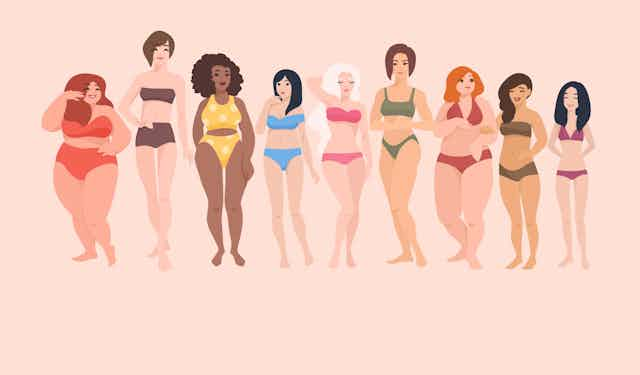In the past 30 years, there has been a dramatic increase in body criticism. Most women, and many men, feel dissatisfied with how they look. They feel too small, round, short, spotty, lined… the list goes on. Unsurprisingly, this has lead to an increase in poor self-esteem and low levels of confidence.
One key source of this body criticism is the media (from TV and billboards to social media), which – despite more body diverse campaigns – continues to promote the “thin ideal”. As we all are spending more time at home consuming media and less time moving our bodies, we need to show ourselves more body kindness for the sake of our mental health.
Read more: Thank you bikini terrorists for moving us on from throwback diet ads – now #eachbodysready
Thankfully, in recent years there has been a welcome backlash against this approach and a call for greater body diversity in the media.
In our latest study 106 women aged 16 to 30 rated how they felt about their bodies before and after seeing one of three sets of 26 images. The first set was of neutral images of household objects, the second set was of images of a women’s bodies and faces that were far more diverse in terms of size and shape than we usually see, and the third set reflected the more traditional thin-ideal images of women we are so familiar with.
The results showed that seeing the body diversity images made participants less critical of their bodies but more critical of the media’s use of “thin-ideal” images. Simple exposure to greater body diversity had an immediate impact on how they felt about themselves.
The power of the media
The media is all-pervasive and bombards us with images through the TV, billboards, films, our computers and our phones. This can result in two key processes without us even knowing it. The first is social comparison as we make unfavourable comparisons between ourselves and the media world. This makes us feel like we have failed, underachieved and are destined to be nobodies. The second is internalisation, whereby we internalise the images and change our mindsets to believe that these are “normal”.
For body criticism, when we view the all-pervasive and narrow range of “thin-ideal” images of women in the media, our social comparisons tell us we are not good enough and our internalised new normal enables this upward comparison to continue even when the images are no longer there.
Yet the power of the media goes beyond its all-pervasiveness and is exacerbated by a clever sleight of hand. Because the media is everywhere, we think that what we are seeing is everything there is to see. That the news is all the news, the science is all the science and that the culture is all the culture. There is so much of it that it must be all of it. But without knowing it, we are all trapped inside our little echo chambers that simply feeds us more of what we are used to. So we see a very narrow range of images of women because this is what the media uses.
Read more: The problem of living inside echo chambers
On top of this, we’ve all noticed how the internet watches what we look at and suggests more of the same. This narrows the range of what we consume down even further to create an even more restrictive echo chamber. And, as we never see anything to contradict this media controlled world, we believe that these images are normal – so the downward spiral continues. And when could be a worse time for this to happen, than when the world is in lockdown and our worlds have become the narrowest they have ever been?
Exit the echo chamber
The media needs to promote body diversity more and stop championing one body shape over others. The images we used were from Portrait Positive, developed by event organiser Stephen Bell and fashion designer Steven Tai, in 2018. This project aimed to defy traditional beauty perceptions by photographing 16 females with visible body and facial differences and was in support of the leading Changing Faces charity.
Together with the body positivity movement – and recent campaigns such as those by Dove, #ThisGirlCan and womenswear company Aerie – initiatives like this have challenged the media to move away from their narrow ideals of beauty.
We could also simply look elsewhere for our norms. The media may well bombard us with a narrow idea of beauty, but when we look up from our phones or computers the real world does a wonderful job of body diversity. Out there, there are fatter, thinner, older, younger, balder, hairier, wrinklier, wobblier, bigger-nosed and smaller-mouthed people than anything we will ever see on our screens.
And this is where we should be looking for both our social comparisons and internalisations. Our friends, colleagues, family members and passersby present us with the perfect set of body diversity norms. So when this lockdown ends, if we could remember to look up, rather than down, our range of normality could quickly become broad, unrestricted, healthy and positive again.

